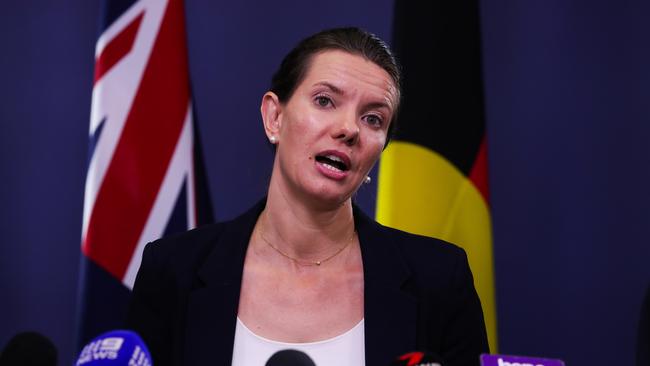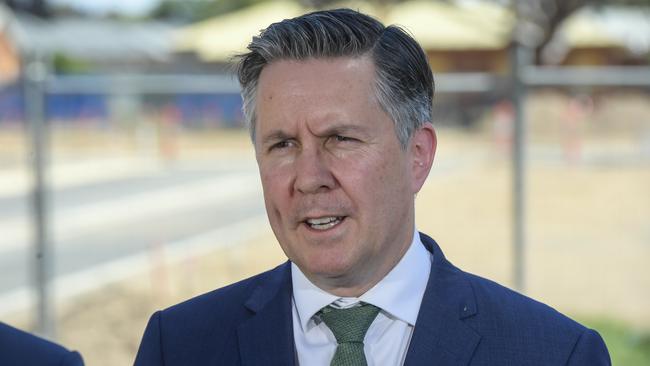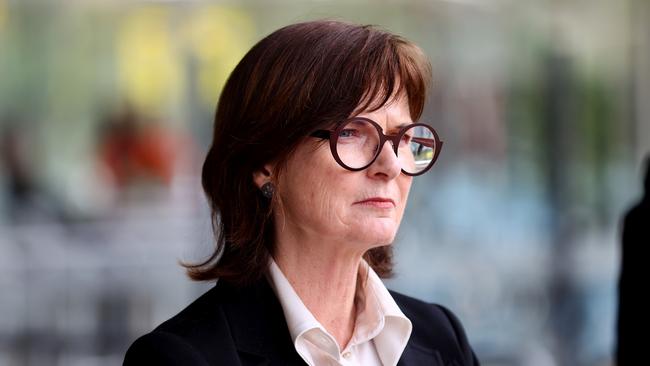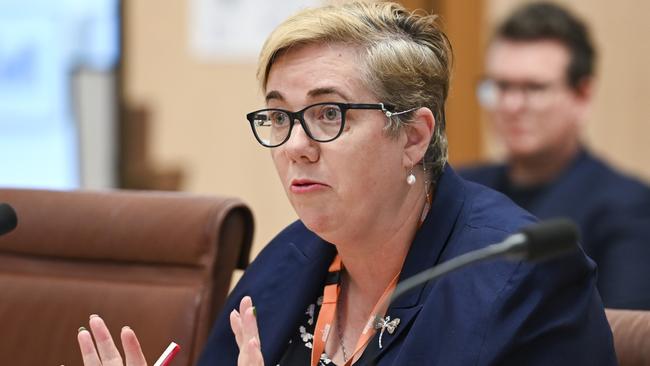Expect access to a specialist doctor if you need one? Don’t be so sure
The mass resignation of psychiatrists from the NSW public hospital system may be only the first tremor of a seismic shift in the way our public hospitals work in the future.

You can now listen to The Australian's articles. Give us your feedback.
The NSW psychiatry crisis, triggered by the resignation of more than 200 psychiatrists in dispute with the government over pay and conditions, did not arise in a vacuum. Specialist psychiatrists were under pressure for decades as longstanding neglect left the mental health system in tatters and system-wide understaffing made workloads intolerable.
As acute as these problems have become, though, they are not restricted to NSW. A recent national analysis undertaken jointly by The Australian and the Australian National University revealed a projected looming national shortfall of more than 2000 psychiatrists.
Emergency departments around the country already struggle with demand. The Australian Institute of Health and Welfare reports that almost 300,000 emergency department visits each year are related to mental health. General practices have been overwhelmed for years and, with public hospital services cut back, will have nowhere to send patients needing specialised mental health care.
Yet while the workforce crisis in psychiatry is particularly acute in NSW – hundreds of public hospital psychiatrist positions were unfilled well before the present crisis erupted – it is a microcosm of pressure weighing on public hospitals and health services around the country. In many areas – and across disciplines such as obstetrics, anaesthesia and emergency medicine – the specialist workforce is cobbled together by locum doctors and other workarounds.
As the public hospital system begins to crack around the country, the results could reshape everything we have come to expect from our public hospitals.
The way the NSW government has responded to the psychiatry crisis also provides clues about the way governments are likely to deal with looming workforce pressures. In the background, allied health groups are already sharpening their strategies, ready to expand into the gaps left by departing doctors.
When it became clear that the psychiatrists were not backing down, NSW Mental Health Minister Rose Jackson revealed her government’s fallback strategy to plug the holes left by departing specialists. Social workers, peer workers, clinical psychologists, nurses and GPs – all could be asked to take on additional responsibilities.
“The system is resilient. (The) system is agile,” Jackson said at a press conference on January 23 in an attempt to reassure an increasingly fearful public. “We have other health professionals stepping up, putting their hands up to play a role.”

The minister’s plan drew fire from the NSW AMA, with acting president Dr Fred Betros responding the next day in a media release. “It is very concerning to read commentary … regarding proposed radical reform of the NSW mental health system which would see highly skilled doctors replaced by other staff,” he said.
“Healthcare is a collaborative space where doctors work closely with nurses, allied health staff and social workers, but every staff member plays a vital role in the treatment and recovery chain,” Betros said. “Any suggestion psychiatrists are superfluous to a patient’s needs is derogatory and dangerous.
“Psychiatry is not the only specialty feeling the pain of an underfunded and under-resourced public health system,” he said. “NSW Health is currently experiencing a systemic crisis with staff struggling to meet demand across the board.”
Pressure on the system
Betros was speaking an uncomfortable truth to power. Around the country, patients at public hospitals contend with long waiting lists for planned surgery, strangulation of care in our emergency departments, and ballooning waiting lists for hospital specialist appointments. The pressure on the system is obvious.
What should the community expect from our public hospitals? “Australians want safe care and they want high-quality care,” says Elizabeth Deveny, chief executive of the Consumers’ Health Forum.
“But I would say in the last 18 months that’s probably shifted a little, because now what people are saying is, ‘I’m happy with any care, even if it’s not the safest or the highest quality, because I can’t afford the safest and the highest quality’.
“As a consequence, people are increasingly making decisions that are not in the best interests of their health based on cost because they can’t afford the quality of care and the public system can’t deliver the care for free.”
Federal Health Minister Mark Butler told the ABC in November that “demand for health is growing and will grow, as long as I can see into the future, and workforce is hard to come by. It just doesn’t make sense not to use every skerrick of skills and training that all of our health professionals have, from GPs through to nurses through to pharmacists, physios and more.”
Butler is not exaggerating when he says the workforce is hard to come by. Training to become a surgeon or anaesthetist, for example, may take as long as 15 years from start to finish. Almost all of specialist training takes place in public hospitals, so shortages of trained specialist doctors hobbles training of the next generation.

Around the country medical care is hamstrung by shortages of specialist doctors. The situation is acute in rural and regional areas of the country. In Queensland it is almost impossible for women to find a maternity unit outside of the largest regional cities. Not only is this a major issue for regional Queensland families, but it became a throbbing political headache for the former state government.
In an interview in 2023, the then National Rural Health Commissioner, Professor Ruth Stewart, complained successive state and territory governments were not “upfront” about why services continued to be chopped. The reason was maternity services around the country were struggling to recruit and retain staff, with Queensland the hardest hit.
Rural Doctors Association of Australia chief executive Peta Rutherford at the same time bemoaned the fact hospitals were being propped up by a “rotating door of locums”. This was particularly unappealing for expectant mothers seeking certainty.
In Victoria, the problem was a shortage of anaesthetists. With eye-watering waiting lists for planned surgery across the state, and a shrivelling budget for public hospitals, the Health Department was so desperate it was offering up to $10,000 a day in an attempt to secure anaesthetists for some regional hospitals. Although data projections are difficult to come by, independent modelling by the Australian Society of Anaesthetists suggests a shortfall nationally of more than 500 anaesthetists by the end of the decade.
Plugging the gaps
Australian governments spend $96bn each year running our public hospitals. Staff costs are the single biggest component, representing almost 60 per cent of the total spend. The vast majority of that goes to nursing wages, which totalled almost $23bn in 2023. The cost of specialist doctors’ wages was $7.7bn over the same period.
Access to healthcare is a critical issue for the state and territory governments who run our public hospitals. With specialists in short supply, plugging the gaps requires either a locum workforce, other health professionals covering the shortfalls, or fast-tracking the arrival of specialists from overseas.
Because of the lengthy processes required to train homegrown specialist doctors, the federal government is looking to fast-track doctors from overseas. Following a 2023 report by former top public servant Robyn Kruk, red tape for overseas-trained doctors wanting to work in Australia is being slashed. The highest priority hospital groups are – as expected – psychiatrists, obstetricians, and anaesthetists. They are also the first, with a second round to include ophthalmologists and other specialties.
Anaesthetists are critical not only to surgery but also to many other areas of healthcare. They have been bruised before, though. In 2013, Professor Brendan Murphy – who would go on to become Health Department secretary during the pandemic – foreshadowed the latest thinking in state health department c-suites.
“There is no reason why you couldn’t have obstetric epidurals done by nurses,’’ he said, spicing up his comments by saying that many anaesthetists were often “bored” with routine aspects of their jobs. “For 99 per cent of the time, they are just squirting in drugs, putting someone to sleep and then once a month something dramatic happens and they have a life to save and get excited.’’
The comments did not go down well with anaesthetists, drawing a sharp rebuke from professional groups, and Murphy graciously apologised. Anaesthetists’ groups said Murphy’s comments showed a “monumental lack of understanding’’ about what they did. However, Victorian Health Department trials went ahead with nurses undergoing training to perform procedures such as colonoscopies and cystoscopies that, usually, were undertaken by specialist gastroenterologists and urologists.
Murphy defended his comments by saying nurses cost a hospital less, freed up doctors to do more complex work, and helped cut waiting lists. Such changes were necessary, he said, in the face of rising demand for healthcare, unsustainable costs and workforce shortages.
The medical workforce situation has not improved in the decade since. Butler said last year that reform was necessary in “how we use the best-trained health workforce on the planet”.
He was commenting on a report about increasing the “scope of practice” for all healthcare workers. The report, he said, made clear that “there are all sorts of artificial, inefficient restrictions on what nurses, pharmacists … and other health professionals are allowed to do that bears no relationship to their training”.
“There are turf wars in health,” Butler said, referring to doctors’ groups concerns. “At its worst, frankly, I think sometimes this sector reminds me of factories back in the 1970s with very strict demarcations. We were able to break them down, get much more efficiency into manufacturing, and much more value and reward for the workers involved.
“I know that this is not only going to be good for patients and make a more efficient system. But it’s also going to be good for health professionals because we know that they are much happier and more likely to keep working when they feel that all of their skills are being valued.”
Scope of practice
Can professionals such as nurses or nurse practitioners step into the roles left vacant by specialist doctors? Professor Mark Cormack, who headed up the review commissioned by Butler, is cautious.
“I think it’s important to make a distinction between enabling health professionals to work through their full scope of practice,” Cormack says, “and health professionals seeking to expand and modify their scope of practice beyond what it was currently set at.
“It’s absolutely critical that consumers seeking health services … receive care from those people who are qualified, competent and authorised to perform the various health services that they require in areas of extreme shortage or under-servicing.
“So it’s not a case of saying that anything goes because there’s a workforce shortage, whether it be an acute or long term,” Cormack says. “It’s that whoever’s going to be performing those essential roles are appropriately trained, recognised, accountable and regulated.”
Cost-saving is on the minds of treasurers as well as state health ministers. The Victorian health system is hundreds of millions of dollars in the red. When the Victorian government walked back targets on elective surgery – a hot political issue – two of the stated reasons were pressures on emergency departments and lack of surgical staff.

Victorian Health Minister Mary-Anne Thomas said the government had set “ambitious” targets but had to “recalibrate” due to a shortage of trained staff in hospitals. “Whilst we’ve delivered more planned surgeries than ever before, we’re not going to reach that target and the thing that holds us back … is we’re still not able to access the workforce that we need,” she said.
Australian Salaried Medical Officers Federation president Dr Tony Sara has spent years working with state health department bureaucrats. “I think that there are some people in health departments that don’t like doctors and would like to see them replaced – but I don’t think it’s a huge number,” he says. Faced with areas of acute workforce crisis, Sara says “those people who are saying, ‘Look, we can do without the specialist doctors’ then find their views get a little bit more light.”
Sara is not so sure how this approach appeals to the broader community. “From what I’ve seen, the community are not accepting of that,” he says. “The community are supporting the specialist psychiatrist, despite the fact that it’s been portrayed by the government as just about the money. The community isn’t buying that argument. They’re saying we want specialist psychiatrists to provide care for us and the community and our loved ones in public hospitals.
“The government wants to be seen to be reducing anxiety in the population. So therefore, they’re going to use any arguments they can to reduce the community fear about not having the special psychiatrist in the public hospital,” said Sara. “So they’ll say, ‘we’ll get locums, we’ll get people from interstate, we’ll increase task substitution, we’ll get other staff to operate to the top of their limits of practice’. So it’s about reassuring the community. Whether it’s true or not is irrelevant.”
Australian Society of Ophthalmologists president Dr Peter Sumich says “it’s very tempting for governments to believe they can substitute because they don’t understand the depth and experience it takes to be a specialist in an area, and superficially it looks attractive”.
“But when you consider that perhaps a paramedical may be as good as the specialist 60 per cent of the time, it’s that other 40 per cent of the time where omissions are made, or mistakes are made, or simple things aren’t completed in a way we would do them that matters,” Sumich says.
“So there’s a depth and breadth of experience that comes with time and education, and that can’t be replicated in anything other than a medical degree.”
Addressing the lack of maternity services for Queensland women, the president of the National Association of Specialist Obstetricians and Gynaecologists, Professor Gino Pecoraro, sees parallels between the NSW psychiatrists crisis and the issues in his own state. Like others, he emphasises the team approach that is necessary. “In exactly the same way that psychiatrists can’t work without social workers and psychologists,” he says, “obstetricians can’t work without midwives and all the other people of the team who do it. Why Australia has the great results we have in healthcare is because we use everybody in the team to do what they are trained to do.”
But he cautions: “The job of a psychiatrist is different to the job of a psychologist, which is different to the job of the social worker, and you can’t just interchange them because they’ve got totally different skill sets.”
Many people have been surprised to learn of the public hospital system’s reliance on locums to fill long-term gaps. “The proper role for locums should be to backfill the gaps left when the permanent staff or the senior staff or those people who have got long-term work in hospitals need to go on leave or be part of just filling in those gaps in the roster,” says Dr Simon Judkins, former president of the College of Emergency Medicine.
“The development of a culture of safety and support, being able to develop processes and procedures within your department that everybody who works there understands and has input into – with the ultimate goal of patient safety and avoiding poor outcomes for patients – is incredibly important,” Judkins says.
“And I think that role is very difficult when you have staff, particularly senior medical staff, who are constantly rolling in and rolling out of a department, who may not be familiar with processes and procedures and may not necessarily be engaged in trying to provide high quality service.”
Judkins says nurturing a permanent specialist team can lead to “a decrease in delayed diagnosis, complaints from patients and staff, all those things that improve when you’ve got a good quality service, and they will have financial impacts as well.”
Pecoraro agrees. “The short-term fix of locums doesn’t have longevity. It’s simply not sustainable,” he says. “I think this is a symptom of what’s happening in healthcare delivery in Australia today as psychiatrists in NSW, but it’s happening in every state, in every specialty.”
Indeed, Judkins says many doctors working in locum roles “want something more significant and more substantial with their career”.
What patients want
“When we see health professionals leave a profession, or stop their full scope of practice, consumers are concerned about it,” says Consumers’ Health Forum’s Elizabeth Deveny. “They wonder, ‘am I going to be able to receive the care that I want and where I need it?’ That’s really worrying for people. It’s not unreasonable for consumers to expect they’ll be able to see the right health professional, whoever that is, when and where they need them, and they tell us that is their expectation.

“People expect a public healthcare system to be reliable and accessible and fair, they know there might be workarounds for all kinds of reasons, whether it’s a flood or an industrial action, but that can never be a permanent solution, right?”
If providing a long-term workforce of specialist doctors for our public hospitals is a priority for state governments – as it must be – then replacing them makes little sense.
“There is this folk law that there aren’t enough specialists because we restrict numbers,” eye specialist Sumich says. “The truth is that they have to be trained in public hospitals. If governments are withdrawing funding from training specialists and clinical services, they can’t blame the colleges for not training up specialists if they’re not putting enough work through public hospitals.”
Sara from the salaried doctors’ union agrees. “We generate the profession of medicine in the public teaching hospital. That’s where the training occurs,” Sara says. “So what the government is potentially saying is we don’t support the training of psychiatrists. We then have this downturn in psychiatry training for years to come, because if you don’t have staff then you don’t get nearly as much training, then those won’t train junior doctors.
“So it means that we’re setting ourselves up for shortages of psychiatrists for years to come.
“It’s very short-sighted. But politicians are interested in politics, not in healthcare, I guess.”





To join the conversation, please log in. Don't have an account? Register
Join the conversation, you are commenting as Logout